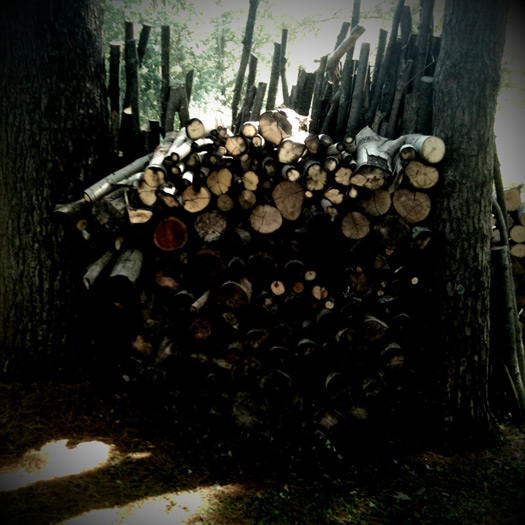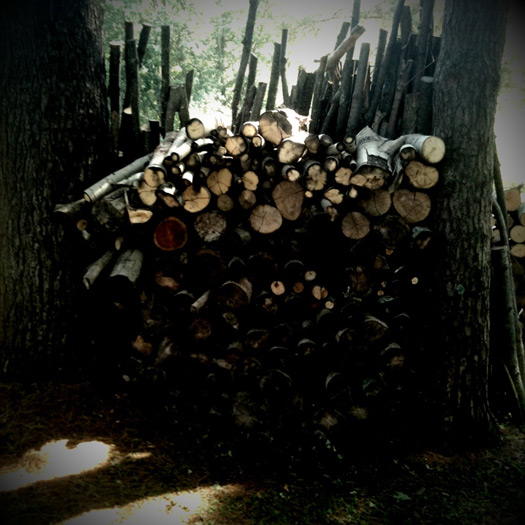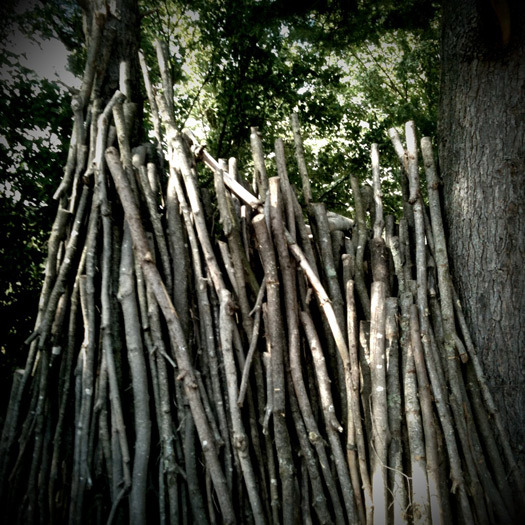
October 6, 2016
The Wood Stacker

Elwood Shaler has been stacking wood for 75 years. His wood piles are the envy of the valley in which he lives. They are unlike the squat pragmatic designs you often see when driving the back roads of New England. They are monumental.
He lives in a tidy white wood framed house with a green tin roof. His garage is as big as the house. It contains an enormous sixteen wheeler for hauling cattle, parked cab end first, a few vintage tractors, a power washer, a buzz saw and a Buick.
He was sweeping the garage floor when I asked if I could talk with him about his stacked wood. He looked at me quizzically. It was as if I had asked him how to walk.

“Did you learn to stack wood from your father?” I asked.
He was quiet for a while. “We lived on a dairy farm just past the Rexley Bridge” he said slowing down to a stop. He kept his face turned away. “Foster Green would come by and stack cords in the woods. A full cord is 8x4x4 but Foster cut face cords which are 8×4. You could then ask him to cut the wood to any length you needed, 16” or 18” or whatever you were burning. It cost a dollar a cord.”
We walked further and came to a 20 foot long wall of wood. “One thing you have to look out for is a short piece,” he said leaning up against the wall. “You just throw those right on top along the with funny shaped ones.” He placed his enormous hands on the stack and gave it a firm push. It swayed back and forth threateningly and then slowed to a stop.
“You see how it gives?” he said. “That’s what you want so that in winter it doesn’t blow over.”
We walked towards one of his singular designs — a wood stack suspended between two trees. The light glinted through the logs even though it was an overcast day. Any number of earthwork artists would be proud to exhibit one of Elwood’s constructions.



“These are maple,” he continued, “but these here are ash.” The bark of the maple had craggy raised spines and oblong rivulets. The pattern of the ash was tighter, diamond shaped, and more regular. “I like to burn hardwoods. Tried poplar once but it was no good.”
I asked about a vertical stack of branches that looked like medieval pikes. “I’m saving those for a friend,” he said, “He’s got a cook stove. Heats his whole place up. So I put those up for him. I’ll cut them down to size with my buzz saw when the time is right.” He laughed. “We call them pecker posts when we’re not in mixed company.”
Elwood picked one up and hefted it like a javelin. “You can tell when they’re ready,” he continued, “They feel light. All the water has been cooked out of them.”

He walked over to a steel bucket and gave it a kick. Inside the bucket were a number of odd shaped split logs. He picked one up and pressed the end of it. It crumbled. “These here are dozy pieces. Every year I burn them up first to get rid of them.” He threw the piece of wood back in the bucket with disgust.

He sat down to rest. We talked about the piping for his hot water and his ritual of coming downstairs on cold winter mornings to clean the grates and rake the coals and then stoke the furnace. We discussed the amount of wood he burns every year.
Underneath the conversation ran a theme of modest pride. All his work, from cutting the wood during the summer, to stacking it in early fall, through to burning it in the winter freed him from a dependency on oil. His heat is local.
He creakily stood up. The conversation was drawing to a close. He smiled. “My friend Jerry says that if a tree comes down anywhere in this valley its not safe from me.”
Observed
View all
Observed
By Adam Harrison Levy
Recent Posts
DB|BD Season 12 Premiere: Designing for the Unknown – The Future of Cities is Climate Adaptive with Michael Eliason About face: ‘A Different Man’ makeup artist Mike Marino on transforming pretty boys and surfacing dualities Designing for the Future: A Conversation with Don Norman (Design As Finale) Innies see red, Innies wear blue: Severance’s use of color to seed self-discovery



